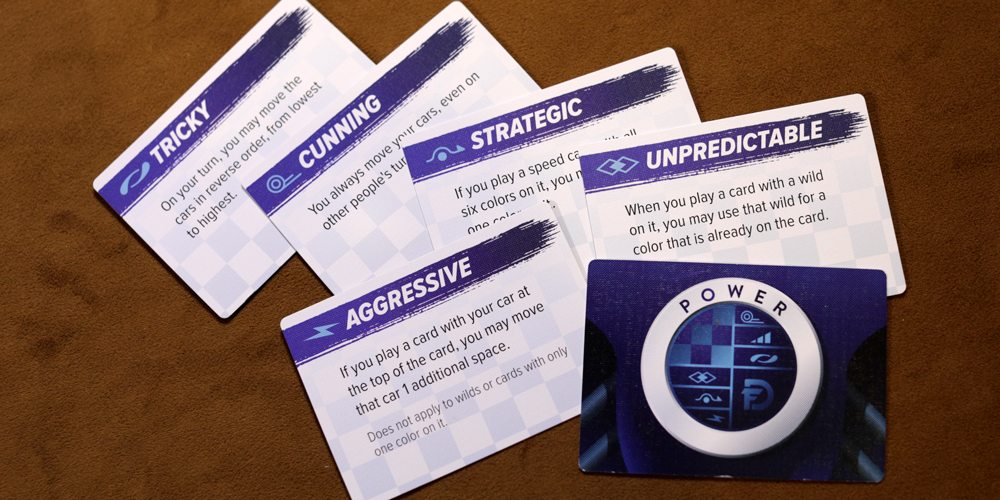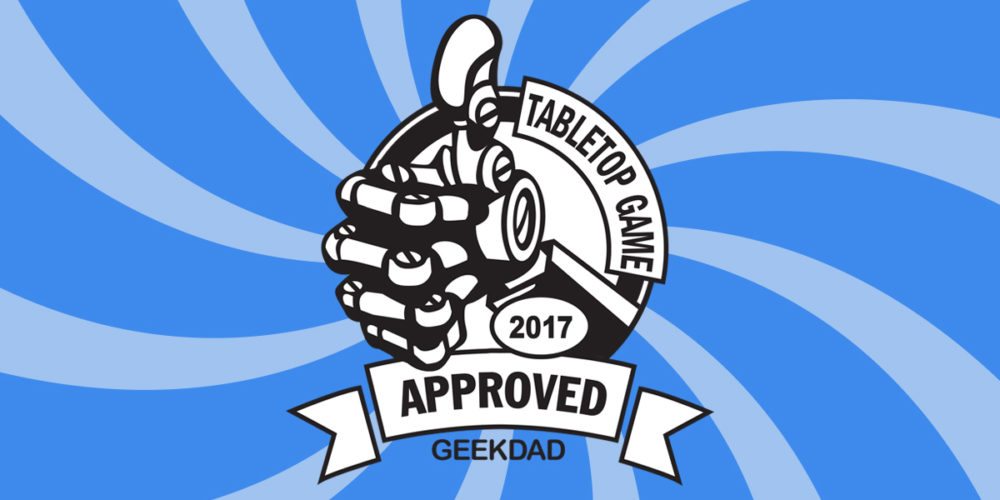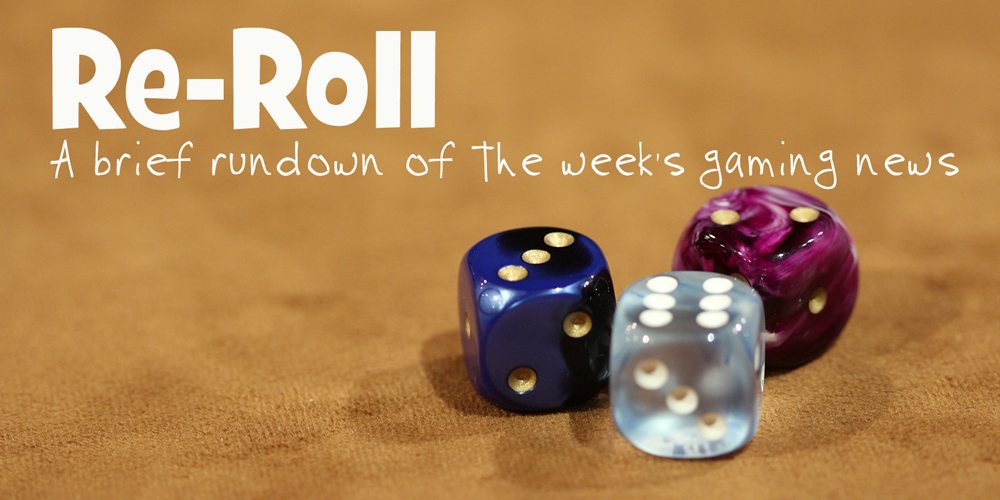
Your team has been funded, the driver trained, engine tuned, and practice laps turned. The lights are about to go out and the race will start. All of your preparations have come down to this, but do you really believe in your chances or should you bet on your arch-rival? The decisions are yours to make in Downforce!
What Is It?
Downforce is a racing game for 2-6 players, aged 10 and up. In the game, players will bid for cars at an auction before racing them around a circuit and bet on the outcome. It’s simple to learn, very enjoyable to play, and takes about 30 minutes to get through a game.
What’s This Restoration Games About?
About a year ago, Justin Jacobson announced he was starting a new company with Rob Daviau (Pandemic Legacy). Their mission is to find old games that they enjoyed and modernize them. The games in their sweet spot are at least 10 years old, out of print, and able to be tuned up for modern gaming. That means more than just a fresh coat of paint (although their restored games all do look amazing). They tear out the bits that aren’t working, add fresh mechanics, and make sure the game is approachable and, importantly, replayable. And, oh yeah, they donate a portion of profits to their charitable partners.
So What’s the Pedigree on This Game?
Downforce started out back in 1974 as a game called Top Race, a race game without a theme. The game was designed by Wolfgang Kramer and he recognized it needed a theme and so he brought it back in 1980 as Niki Lauda’s Formel 1, which is a tiny bit morbid because Niki Lauda’s Formula One career involved almost burning to death in an on-track crash. Milton Bradley printed Kramer’s game in 1990 as Daytona 500 (complete with decals for the cars!) and then disappeared. Until now …

What’s in the Box?
I was very impressed upon taking off the shrink wrap. The box has a slight silk feel to it and has UV spot in several places, telling you that you’ve signed up for a first-class experience. In the box, you’ll find:
- 1 Double-Sided game board (each side has a unique track)
- 6 Race car pawns
- 42 Regular Speed cards
- 6 Speed-8 Speed cards
- 6 Power cards
- 6 Driver Plaques
- 1 Pad of Score Sheets
As with all Restoration games so far, the quality is off-the-charts. The art is perfectly wonderful and no corners have been taken in the production. The cards are high quality and the board, with its multiple folding edges, seems like it will be around for a long time. The plastic cars could have been presented as monochromatic choices, but instead they are two-piece models in dual tones, which really adds to the realism. The art on both sides of the map is fantastic, with one side reminiscent of Monaco or Long Beach, temples of speed, nestled close to harbors. The cards and Driver Plaques are equally great. The quality of the components is great and it is a four-star gaming experience, especially when you consider that the game will retail for about $40.
Downforce is GeekDad Approved!
How Do You Play?
Everyone gets a score sheet and a something to write with. A side of the board is chosen, the Speed-8 and Power cards are shuffled separately into piles and the Regular Speed cards are shuffled and distributed evenly among players. (In four and five player games, there will be two extra cards.) Driver plaques are set by the board and cars are randomly placed on the starting places near the checkered start/finish line. You’re now ready to play.
Downforce is played in three, distinct parts: an Auction, a Race, and in Betting. During the first part, the Auction, the top cards in the 8-Speed and Power decks are revealed; these are the items players are trying to win. To bid, players look at the Regular Speed cards in their hands and select one to be used as their bids. For example, if the red car is first up for bid, players look at their hands and decide if they want the red car. If they do, they find a card that has a red car movement on it. Movement has values from 1 to 6 on the Regular Speed cars. In the Auction, this number represents how many millions you want to bid.
All bids are evaluated and the high number in the current color wins. If there’s a tie, the card with the most cars on it wins. If a player doesn’t want to own the car, he may bid a card with a low number for that color or a card that doesn’t have that color on it. The player who wins the current auction gets the Speed-8 card for that car and adds it to her hand. She also gets the Power card that was in the Auction, which is set in front of her, and the Driver Plaque for that color, which is also placed in front of her. Finally, the winning player marks the value of her bid on her score sheet next to the car she won. For instance, a winning bid of Red 4 is marked as a 4 next to red in the Auction Price column on the Score Sheet.

Any card that is used to bid is returned to that player’s hand and that card can be used again during the Auction. Speed-8 and Power cards continue to be revealed until all cars have been auctioned. Every player must have at least one car and, as the auctioning progresses, when the number of available cars equals the numbers of players without cars, only those players may bid. If a player has won more than one car, they may only use one Power card. Any extras are returned to the box.
Now the racing happens. The car sitting on the pole position spot gets to go first and selects a card from their hand that they want to use. All movement has to be taken (unless the car is blocked) and is resolved from top to bottom on the card (unless a power allows otherwise). Any card that is played is placed in the discard pile. Wild cars can be applied to any color car except those that are already on the card (unless you have a power that says otherwise). Cars must move forward. Side or backwards movement is not allowed. Cars may move diagonally and any movement is considered forward if the front end of the space is beyond the front end of the space where the car currently sits.

At three points on each circuit there are yellow lines crossing the track. Once a car crosses the first of those yellow lines, a first round of betting occurs. Players mark on their Score Sheets which car they think will finish the race in a podium position. Players bet after each time a yellow line is crossed by the leading car and may bet on the same car every time.
As cars cross the finish line, they are placed on the appropriate finishing places. Play continues until all cards and movement have been used. It’s possible for a car not to cross the finish line and this car is considered abandoned and does not score any racing points. Once all cards have been played, players tally their Score Sheets, awarding themselves payout money for how their cars finished the race, adding any winnings from any bets that resulted in podium finishes, before subtracting what they bid on the cars they won. Highest total wins the game.

Why Should I Put ‘Downforce’ in My Collection?
As a race fan, I was immediately drawn to the theme of Downforce, but I wasn’t really sure what to expect, having not played any of the previous iterations. As it turns out, I’ve been playing this game a lot since it showed up. So much so that I’ve used nearly half of the Score Sheet pad, leading to some depleted Score Sheet anxiety. (Restoration promises to put downloadable Score Sheets up at some point.) However, my enjoyment of the game isn’t even closely tied to the theme — it’s just a fantastically fun game that a wide audience can enjoy.
It really feels like there’s something for everyone in this game. The Auction mechanic will have you evaluating your hand, trying to figure out which color will serve your given movement the best (don’t forget to add in the Speed-8 card which will give a speed boost to your color, alone). If you want a car, you want to bid enough to get it, but not so much that you hurt yourself in end-of-game accounting. Bid too low and you’re stuck with a car that you may not have the movement cards in your hand to advance.

The racing portion of the game can get a little nasty as players will force cars to stop at pinch points and then use up big movement cards for those unlucky drivers stuck behind those cars. It’s also a test in diplomacy as nearly every game has had some negotiation between players, begging for the active player to advance other cars in the game. There is also a healthy bit of hand management involved in the race portion. You want to advance your car as much as possible, but without too much advantage of your opponents. Because there ends up being equal movement for all cars across cards, all cars should finish, but an impeded position may cause a car to lose significant momentum. What’s more, a player may not want to move ahead too quickly because it may paint a target on their rear wing. You have to be very aware of the upcoming track and how cars are currently positioned on the circuit. Because cards must be resolved in their card order, the best laid plans can be dashed by forgetting that the car behind yours may end up in front of you before that tight right-hander or chicane. And then come the turns when you have to move your opponent ahead first, because that’s the only card you have. You may find yourself howling in enjoyment or in pain.
The Power cards add fun and great advantages to play. Benefits include being in control of your car’s movement (regardless of whose turn it is), gaining extra movement if all other movement you made was done on a straight, using Wild movement for a color already appearing on the card, and more. Additionally, the Power cards feel well-balanced. None seem to give a player a distinct advantage and each is enjoyable to use in your own race.What’s more, I was pretty excited to see this Tweet from Restoration Games’ J.R. Honeycutt. It seems like added Power cards might be on the way and some of them look pretty great.

The Betting is quite fun too, although it consistently feels like the car that makes it through the first single-lane sector has a significant advantage over the competition. If another car is close, the outcome may be in doubt, but too often the first car through seems to be the winner, but it’s not enough to detract from how much fun this game is to play. In fact, in a number of games, players have done well to ignore their own race and concentrate on getting the lead car to the finish lie first. The combined score of a low Auction, decent Race finish, and high Betting can propel a player to an overall win.
I really enjoy Downforce. I can teach this game in about two minutes and whenever we sit down, we always play at least two games, sometimes more. There are beginner rules, but I think the game is simple enough, you can jump right in with the full ruleset. There are a couple of rule variants for two-player, long distance, and a world tour, but none of them are much better than the standard rules. Pretty much everyone I’ve played with has enjoyed the game too. Even though it might take a game to really get the gameplay down, a second game is always just across the finish line. There’s not much I’d change. Really, the next step for me is to figure out how to print the maps at double-sized so I can use 1:43 F1 cars and make sure Lewis Hamilton & Mercedes loses every time. That and print some more Score Sheets.
Downforce will release at Gen Con and be in game stores soon after the Best Four Days in Gaming.


Disclosure: GeekDad received a sample of this game for review purposes.






Oh NO! I had so much respect for you right up until that comment about Lewis Hamilton and Mercedes. Now I have to re-evaluate every bit of advice I’ve ever received here. What if Root and My Little Scythe actually suck? Christmas is ruined. Sad. So sad.